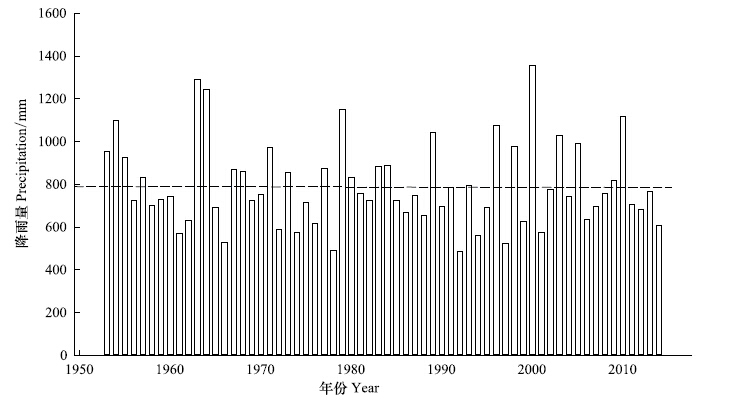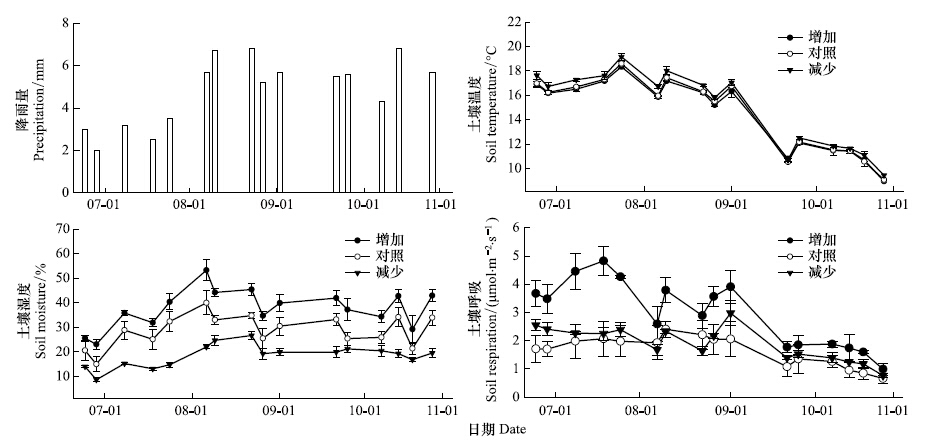文章信息
- 刘彦春, 尚晴, 王磊, 田野, 琚煜熙, 甘家兵
- LIU Yanchun, SHANG Qing, WANG Lei, TIAN Ye, JU Yuxi, GAN Jiabing.
- 气候过渡带锐齿栎林土壤呼吸对降雨改变的响应
- Responses of soil respiration to changing precipitation regimes in an oak forest at a climate transitional zone
- 生态学报[J]. 2016, 36(24): 8054-8061
- Acta Ecologica Sinica[J]. 2016, 36(24): 8054-8061
- http://dx.doi.org/10.5846/stxb201505251043
-
文章历史
- 收稿日期: 2015-05-25
- 网络出版日期: 2016-04-12
2. 黄河水利职业技术学院, 开封 475004;
3. 河南省宝天曼国家级自然保护区管理局, 内乡 474350;
4. 河南省鸡公山国家级自然保护区管理局, 信阳 464134;
5. 河南省信阳市南湾林场, 信阳 464031
2. Yellow River Conservancy Technical Institute, Kaifeng 475004, China;
3. Administrative Bureau of Baotianman Nature Reserve, Neixiang 474350, China;
4. Administrative Bureau of Jigongshan Mountain Nature Reserve, Xinyang 464134, China;
5. Nanwan Forest Farm, Xinyang 464031, China
根据IPCC第5次评估报告[1],自1901年以来,北半球中纬度地区平均降雨量呈增加趋势,增幅达到6%—8%。未来百年内,高纬度和赤道地区的年均降雨量很可能呈增加趋势;而在中纬度和亚热带地区,干旱地区的年均降雨量呈减少趋势,而在湿润地区年均降雨量则呈增加趋势。就中国区域而言,过去50年降水量无明显变化,然而降雨频率明显减少,这意味着单次降雨强度呈增加趋势[2]。徐影等研究认为我国华中部分地区在本世纪末,降雨可能会减少10%—30%[3]。降水格局的改变直接导致土壤有效水分的变化,可影响植物地下及地上器官的生理代谢活动和土壤微生物构成及其活性,进而调节陆地生态系统碳循环的相关过程[3]。因此,降雨格局改变与陆地生态系统碳循环之间作用关系的研究已经是全球变化研究中的重要内容和热点问题。
土壤呼吸是陆地碳循环过程中的第二大碳通量组分[4],全球每年土壤呼吸的碳排放量为(98±12) Pg C,占整个陆地生态系统呼吸量的60%—90%[5-6],对大气CO2浓度变化以及全球气候变化起到至关重要的作用。土壤呼吸强弱受到生物和非生物因素的综合调控,其中与降雨量密切相关的土壤水分条件是重要的环境驱动因子之一[7-8]。因此,土壤呼吸对降雨变化的响应规律受到广泛关注,土壤呼吸对降雨的响应方式因植被、土壤和气候的差异而不同。在水分限制的生态系统中,降雨增加通常可刺激土壤呼吸。例如,在亚热带的稀树草原开展的降雨改变研究发现[9],降雨增加导致草地和木本植物群落下的土壤呼吸分别增加48%和103%,并且提高了土壤呼吸的温度敏感性。这种不同群落地下土壤呼吸对降雨处理的响应差异可归因于植物下土壤微生物量、土壤碳库和根系活性等方面的差异。此外,在荒漠灌丛[10]和高草草原[11]系统中,降雨增加对土壤呼吸具有明显的促进作用。由于森林生态系统类型的多样性,分布的广泛性,其土壤呼吸对降雨增加的响应较其它系统更为复杂,受到诸多环境因素的调节。例如,在我国热带雨林中开展的降雨改变实验发现[12],土壤呼吸对降雨量增加的响应受到土壤初始水分条件的调节,干季时增加降雨会促进土壤呼吸,而在湿季则抑制土壤呼吸,这种差异可能与不同时期优势植物的生理活动和土壤微生物代谢有关。降雨减少也会调控土壤呼吸强弱。在热带雨林生态系统中开展的研究表明,土壤呼吸对降雨减少的响应表现为增加、减少和无变化,响应的多样性与土壤的质地和植物特征有密切的关系[13-16]。而在温带落叶阔叶林中的研究发现,降雨减少会抑制土壤呼吸,因而可能有利于土壤碳的积累[13]。
作为生态脆弱区和敏感区域,气候过渡带的植物和土壤对气候变化的响应更为迅速和敏感[17]。然而,以往的降雨改变实验大多集中于典型气候带下的生态系统,在气候过渡带中开展的降雨改变研究仍较为缺乏。气候过渡带的温度和水分状况是分布于此的南北物种维系生存的临界值,在全球气候变化背景下,过渡带降雨格局改变对森林生态系统碳循环过程的影响可能更加直接和显著[17]。降雨格局改变如何影响过渡带森林生态系统土壤碳循环仍不清楚。以我国河南南阳地区为例(图 1),多年平均降雨量为791.9 mm,极端干旱年份(1992)降雨量为484 mm,极端湿润年份(2000)降雨量为1356 mm,降雨年际波动介于-39%—+71%之间。这种剧烈的年际降雨差异必然会对陆地生态系统碳循环过程产生深远影响。本研究以我国亚热带—暖温带过渡区域的落叶阔叶林(Quercus aliena)为研究对象,通过开展林下穿透雨增加50%和减少50%的野外实验,以揭示土壤呼吸及其温度敏感性对降雨增加和减少的响应规律,为准确评价气候过渡带森林生态系统土壤碳循环过程对全球变化的响应提供基础数据和科学指导。
1 研究区自然概况研究地点位于河南省内乡县宝天曼自然保护区(111°47′—112°04′ E,33°20′—33°36′ N),相对海拔高度600—1800 m,最高峰曼顶海拔1830 m。年平均气温15.1 ℃,1月平均气温15 ℃,7月平均气温27.8 ℃,≥10 ℃的年积温为4200—4900 ℃。年均降水量为791.9 mm (图 1),大多集中分布于6—8月份的雨季,年蒸发量991.6 mm。土壤垂直分布明显,海拔1300 m以上为山地棕壤,海拔800—1300 m为山地黄棕壤,海拔600—800 m为山地褐土,土壤厚度20—60 cm,土壤pH值6.5左右。该地区属于我国北亚热带—暖温带的过渡区域,植被以暖温带落叶阔叶林为主,兼具有亚热带常绿落叶阔叶林特点,栎类是宝天曼的主要建群树种,约占整个乔木树种的70%。
2 研究方法 2.1 样地选设及处理布置在宝天曼森林生态站附近(海拔1410 m),选择地势相对平坦(坡度小于5°)的锐齿栎林(胸径(18.2±2.4)cm,密度1276.7 株/hm2,林龄: 45a)开展降雨改变实验。设置4个区组,彼此间隔为10 m。在每个区组内布置3个2 m × 2 m的样地,彼此间隔为2 m,每个样地实施一种降雨处理。① 降雨减少:在样地正上方用透明的波浪式PC玻璃瓦搭建减雨棚,每间隔10 cm铺一条10 cm宽玻璃瓦(V形,透光率大于95%),以实现减除降雨的50%,一侧高度为1.5m,另一侧高度为1.2m,落差保证降雨顺利沿沟槽流下;② 降雨增加:将降雨减少样地排出的雨水收集到水桶中,每次降雨结束后24h将雨水通过喷壶均匀的喷施到降雨增加样地,喷洒速度以无明显地表径流为宜;③ 对照:无降雨处理。所有样地分布于林木间隙,顶部无明显树冠遮拦,样地内无乔木和杂灌木生长。由于地势平坦,降雨过程中的地表径流较少,而潜在的地下侧流过程本研究未考虑。样地处理之前,测定林下土壤湿度介于14.3%—17.8%之间,样地布置于2013年6月15日完成并开始进行处理。
2.2 土壤呼吸及土壤温湿度测定在每个样地的正中央,安置一个土壤呼吸环(直径20 cm,高8 cm,埋入土壤深度为5 cm)。在降雨处理设备安装完成之后,从2013年6月25日开始,利用Li-8100每周测定1次土壤呼吸,测定时间为每天11:00—14:00完成。同时用Li-8100自带的土壤温度探头和湿度探头测定土壤5 cm深的温度和湿度。数据测定持续一个生长季(6月至11月)。
2.3 数据处理与分析野外测得土壤呼吸、土壤温度和土壤湿度数据首先进行正态性(One sample K-S)和方差齐性检验,均满足条件。然后,采用重复测量的方差分析(Repeated measurement ANOVA)检验降雨处理及测定时间对土壤呼吸、土壤温度和土壤湿度的影响。单因素方差分析(One way ANOVA)和多重比较(L-S-D)检验降雨处理对各测定指标均值的影响。并通过多元回归分析和偏相关分析(Partial correlations)研究了土壤温度和土壤湿度对土壤呼吸的影响。所有统计分析在SPSS 10.0中完成,绘图在Sigmaplot 10.0中完成。

|
| 图 1 研究区年均降雨量的年际波动 Fig. 1 Annual fluctuation of precipitation in the experimental site 虚线代表多年(1953—2014)平均降雨量 |
不同降雨处理下的土壤温度均表现出显著的季节波动(表 1,P<0.0001),在7月下旬达到最大,而在10月底达到最低(图 2)。降雨改变对土壤温度有显著影响(表 1,P = 0.002),表现为降雨减少导致10 cm深土壤温度平均增加0.44(0.19—0.75) ℃。然而,降雨增加(14.5 ℃)与对照(14.6 ℃)之间的土壤温度并无显著差异(图 2和表 2)。测定时间与降雨处理之间无交互作用(表 2)。
| 因子 Factor | 土壤温度 Soil temperature /℃ | 土壤湿度 Soil Moisture /% | 土壤呼吸 Soil respiration/(μmolm-2s-1) | |||
| F | P | F | P | F | P | |
| 时间 Time | 228.500 | <0.0001 | 57.296 | <0.0001 | 33.599 | <0.0001 |
| 处理 Treatment | 21.322 | 0.002 | 70.042 | <0.0001 | 19.510 | 0.002 |
| 时间×处理 Time×Treatment | 1.686 | 0.186 | 4.797 | 0.057 | 4.191 | 0.005 |
| 处理 Treatments | 土壤温度 Soil temperature /℃ | 土壤湿度 Soil moisture /% | 土壤呼吸 Soil respiration /(μmolm-2s-1) |
| 增加Increased | 14.46±0.16a | 37.66±2.22a | 2.96±0.02a |
| 对照Control | 14.57±0.06a | 28.74±2.58b | 1.64±0.06b |
| 减少Decreased | 15.01±0.09b | 18.49±0.56c | 1.89±0.47b |
| 表中数值为平均值±标准误,同一列不同处理间字母不同者表示差异显著(P<0.05) | |||
不同降雨处理下土壤湿度具有明显的季节变化(P<0.0001),在8月初湿度相对较高,而在6月底较低。在观测期间内,降雨量平均为3.8 mm/day,与土壤湿度波动具有较高的一致性(图 2)。降雨处理显著改变土壤湿度(表 1,P<0.0001),按大小依次为:降雨增加>对照>降雨减少。与对照相比,降雨增加导致平均土壤湿度显著上升8.92(4.98%—13.28%),而降雨减少则导致土壤湿度显著下降10.25(4.20%—17.96%)(图 2和表 2)。降雨处理与测定时间的交互作用对土壤湿度无显著影响(表 1)。

|
| 图 2 降雨改变对土壤温度、土壤湿度和土壤呼吸的影响 Fig. 2 Impacts of changing precipitation on soil temperature,moisture and soil respiration |
不同处理下的土壤呼吸具有明显的季节波动,降雨增加下的土壤呼吸在7月中旬达到最大,为4.83 μmolm-2s-1,而在10月底达到最低(0.99 μmolm-2s-1)。对照和降雨减少样地的土壤呼吸则分别在8月初和9月初达到最大(2.98和2.41μmolm-2s-1),在11月初达到最低。降雨处理显著改变土壤呼吸(表 1,P<0.0001)。与对照(1.64 μmolm-2s-1)相比,降雨增加导致土壤呼吸显著上升80.5% (P<0.05),然而,降雨减少则对其(1.89 μmolm-2s-1)无显著影响(图 2)。此外,降雨增加下的土壤呼吸比减少处理高56.6% (P<0.05)。此外,观测时间和降雨处理的交互作用显著影响土壤呼吸(表 1,P = 0.005)。主要表现为,8月前3次的土壤呼吸高于对照样地,而在其他时间则低于对照样地(图 2)。
降雨改变导致土壤呼吸的温度敏感性发生变化(图 3)。降雨增加下土壤呼吸的温度敏感性为4.07,高于对照样地(2.66)和降雨减少样地(2.63)。

|
| 图 3 降雨改变对土壤呼吸温度敏感性的影响 Fig. 3 Impacts of changing precipitation on temperature sensitivity of soil respiration |
通过多元回归分析可知(表 3),土壤呼吸变化可以通过土壤温度和湿度来共同解释,解释量在60%以上。但是,它们在不同处理中的作用又有所不同。土壤湿度在降雨增加样地表现为抑制效应。然而,在降雨减少和对照样地,土壤湿度表现为促进作用。土壤温度在3种降雨处理下均表现为正效应,在增雨处理中最高,而在对照处理中最低(表 3)。进一步进行偏相关分析可知,土壤湿度在增加降雨时与土壤呼吸呈负相关,而在减雨处理和对照样地中是正相关;在增雨样地内,土壤温度与土壤呼吸呈负相关,而在对照和减雨样地内呈正相关(表 4)。
| 处理Treatments | 模型Models | F | R2 | P |
| 增加Increased | SR=-0.360×SM+0.351×ST | 104.402 | 0.823 | <0.0001 |
| 对照Control | SR= 0.029×SM+0.155×ST | 37.538 | 0.625 | <0.0001 |
| 减少Decreased | SR= 0.201×SM+0.181×ST | 129.377 | 0.852 | <0.0001 |
| SR: 土壤呼吸 soil respiration;SM:土壤湿度 soil moisture;ST:土壤温度 soil temperature | ||||
| 变量 Variables | 土壤呼吸 Soil respiration | ||
| 增加Increased | 对照Control | 减少Decreased | |
| 土壤湿度 Soil moisture | -0.896*** | 0.698*** | 0.914*** |
| 土壤温度 Soil temperature | -0.267* | 0.573*** | 0.680*** |
| *P<0.05,*** P<0.0001 | |||
本研究对照样地的土壤呼吸与同区域栾军伟等的研究结果较为一致[18],但是土壤呼吸的温度敏感性则低于后者的研究结果。本研究发现,降雨增加显著提高土壤呼吸,这与全球尺度上土壤呼吸响应降雨增加的趋势相一致。Wu[19]等通过Meta 分析研究发现,降雨增加可使土壤呼吸增加45%。然而在我国的南亚热带森林生态系统中开展的降雨增加实验发现[20],雨季增加降雨会抑制土壤呼吸(-30.9%),旱季降雨增加则会促进土壤呼吸(4%)。降雨增加对土壤呼吸及其温度敏感性的促进作用及响应差异归因于土壤碳库组分和根系代谢的不同[9]。当降雨增加时,一方面,进入土壤的降雨可将土壤毛管孔隙中的CO2通过置换作用将其替换,而在短期内导致土壤呼吸速率的大幅增加[21-23]。从长期效应来看,有研究发现降雨增加会提高植物的细根生物量和微生物量,加快对土壤碳的利用过程,因而可同时提高土壤异养呼吸和自养呼吸[24]。在杰克松林中开展的研究也证实,降雨增加可显著提高细根生物量及根系器官中的总N水平[25],进而刺激土壤呼吸。另有证据表明,在草地生态系统中,降雨加倍降低植物根系的死亡率,而促进细根的生长率[26],进而有提高土壤自养呼吸的可能。在中国鼎湖山季风常绿阔叶林、针阔混交林和马尾松林中开展的降雨改变实验发现[27],增加降雨可提高马尾松林土壤有机碳的矿化量和矿化速率,从而促进土壤呼吸。
4.2 降雨减少对土壤呼吸的影响本研究中降雨减少对土壤呼吸有促进作用,与亚马逊潮湿性热带雨林中开展的林下穿透雨减少实验结果一致[14],后者在降雨减少25%和50%时,均导致土壤呼吸分别增加13%和25%。然而,热带成熟的常绿雨林中开展的35%—41%的林下雨减少实验发现,当单次降雨量较大时,减雨会降低土壤呼吸,从年尺度上估算时,降雨减少对土壤呼吸影响不大[16]。生长于砂壤土上的热带雨林[28],降雨减少50%导致土壤呼吸速率下降25.6%。在美国高草草原上开展的降雨控制实验也发现[29],降雨减少会抑制土壤呼吸。因此,降雨减少对土壤呼吸的影响,可能受到土壤背景水分条件的调节[30]。综上所述,土壤呼吸对降雨减少的响应受到植被类型和土壤质地的影响。降雨减少促进土壤呼吸主要可从以下几个方面解释:首先,在降雨较为充足的地区(本研究区多年平均降雨为792 mm),降雨适当减少有利于土壤的透气性[31],因而在降雨之后一定时期内土壤中微生物活性有被提高的趋势[32]。其次,当降雨减少时,地表凋落物被淋溶下的可溶性有机碳更多的积存和滞留在表层土壤,而不会向深层土壤转移,可直接成为土壤呼吸的底物来源[14]。再次,在干旱条件下,植物通常会降低地上/地下生物量比,即增加地下根系的生长以增加对深层水分的吸收,或者降低地上植物的生长,以降低植物蒸腾带来的水分损耗[32-33]。此外,降雨减少一定程度上提高了土壤表层温度(表 2),有利于土壤微生物和酶活性的提高。因此,降雨减少提高土壤呼吸,进而降低土壤中有机碳的含量[27]。
5 结论降雨格局改变是影响森林生态系统碳循环关键过程的重要驱动因素之一。降雨增加或减少对我国亚热带—暖温带过渡区落叶阔叶林的土壤呼吸有不同程度的促进作用,增加降雨的作用尤为显著,这意味着降雨改变可能会对该区域森林土壤的固碳潜力产生负面影响,进而对大气CO2浓度产生正的反馈作用。本研究仅在一个生长季内进行了观测,土壤呼吸的短期响应是否具有持续性或是出现适应性仍需要长期的观测。土壤呼吸对降雨变化的响应还受到降雨频率和持续时间的影响,以及降雨改变下植物响应策略可能也会对土壤呼吸产生影响。
| [1] | IPCC. Climate Change 2014: Synthesis Report. Contribution of Working Groups I, Ⅱ and Ⅲ to the Fifth Assessment Report of the Intergovernmental Panel on Climate Change. Geneva, Switzerland: IPCC, 2014: 151-151. |
| [2] | Huang G, Li Y, Su Y G. Effects of increasing precipitation on soil microbial community composition and soil respiration in a temperate desert, Northwestern China. Soil Biology and Biochemistry , 2015, 83 : 52–56. DOI:10.1016/j.soilbio.2015.01.007 |
| [3] | Zhang M J, He J Y, Wang B L, Wang S J, Li S S, Liu W L, Ma X N. Extreme drought changes in Southwest China from 1960 to 2009. Journal of Geographical Sciences , 2013, 23 (1) : 3–16. DOI:10.1007/s11442-013-0989-7 |
| [4] | Dixon R K, Solomon A M, Brown S, Houghton R A, Trexier M C, Wisniewski J. Carbon pools and flux of global forest ecosystems. Science , 1994, 263 (5144) : 185–190. DOI:10.1126/science.263.5144.185 |
| [5] | Bond-Lamberty B, Thomson A. Temperature-associated increases in the global soil respiration record. Nature , 2010, 464 (7288) : 579–582. DOI:10.1038/nature08930 |
| [6] | Bond-Lamberty B, Thomson A. A global database of soil respiration data. Biogeosciences , 2010, 7 (6) : 1915–1926. DOI:10.5194/bg-7-1915-2010 |
| [7] | Unger S, Jongen M. Consequences of Changing Precipitation Patterns for Ecosystem Functioning in Grasslands: A Review. Switzerland: Springer International Publishing, 2015347–393. |
| [8] | Yuste J C, Janssens I A, Carrara A, Meiresonne L, Ceulemans R. Interactive effects of temperature and precipitation on soil respiration in a temperate maritime pine forest. Tree Physiology , 2003, 23 (18) : 1263–1270. DOI:10.1093/treephys/23.18.1263 |
| [9] | McCulley R L, Boutton T W, Archer S R. Soil respiration in a subtropical savanna parkland: response to water additions. Soil Science Society of America Journal , 2007, 71 (3) : 820–828. DOI:10.2136/sssaj2006.0303 |
| [10] | 张丽华, 陈亚宁, 李卫红, 赵锐锋, 花永辉. 准噶尔盆地两种荒漠群落土壤呼吸速率对人工降水的响应. 生态学报 , 2009, 29 (6) : 2819–2826. |
| [11] | Zhou X H, Sherry R A, An Y, Wallace L L, Luo Y Q. Main and interactive effects of warming, clipping, and doubled precipitation on soil CO2 efflux in a grassland ecosystem. Global Biogeochemical Cycles , 2006, 20 (1) : GB1003. |
| [12] | Jiang H, Deng Q, Zhou G, Hui D, Zhang D, Liu S, Chu G, Li J. Responses of soil respiration and its temperature/moisture sensitivity to precipitation in three subtropical forests in southern China. Biogeosciences , 2013, 10 (6) : 3963–3982. DOI:10.5194/bg-10-3963-2013 |
| [13] | Borken W, Savage K, Davidson E A, Trumbore S E. Effects of experimental drought on soil respiration and radiocarbon efflux from a temperate forest soil. Global Change Biology , 2006, 12 (2) : 177–193. DOI:10.1111/gcb.2006.12.issue-2 |
| [14] | Cleveland C C, Wieder W R, Reed S C, Townsend A R. Experimental drought in a tropical rain forest increases soil carbon dioxide losses to the atmosphere. Ecology , 2010, 91 (8) : 2313–2323. DOI:10.1890/09-1582.1 |
| [15] | Davidson E A, Ishida F Y, Nepstad D C. Effects of an experimental drought on soil emissions of carbon dioxide, methane, nitrous oxide, and nitric oxide in a moist tropical forest. Global Change Biology , 2004, 10 (5) : 718–730. DOI:10.1111/gcb.2004.10.issue-5 |
| [16] | Davidson E A, Nepstad D C, Ishida F Y, Brando P M. Effects of an experimental drought and recovery on soil emissions of carbon dioxide, methane, nitrous oxide, and nitric oxide in a moist tropical forest. Global Change Biology , 2008, 14 (11) : 2582–2590. |
| [17] | Mahlstein I, Daniel J S, Solomon S. Pace of shifts in climate regions increases with global temperature. Nature Climate Change , 2013, 3 (8) : 739–743. DOI:10.1038/nclimate1876 |
| [18] | Luan J W, Liu S R, Wang J X, Zhu X L, Shi Z M. Rhizospheric and heterotrophic respiration of a warm-temperate oak chronosequence in China. Soil Biology and Biochemistry , 2011, 43 (3) : 503–512. DOI:10.1016/j.soilbio.2010.11.010 |
| [19] | Wu Z T, Dijkstra P, Koch G W, Peñuelas J, Hungate B A. Responses of terrestrial ecosystems to temperature and precipitation change: a meta-analysis of experimental manipulation. Global Change Biology , 2011, 17 (2) : 927–942. DOI:10.1111/gcb.2010.17.issue-2 |
| [20] | 邓琦, 周国逸, 刘菊秀, 刘世忠, 段洪浪, 陈小梅, 张德强. CO2浓度倍增、高氮沉降和高降雨对南亚热带人工模拟森林生态系统土壤呼吸的影响. 植物生态学报 , 2009, 33 (6) : 1023–1033. |
| [21] | Shen Z X, Li Y L, Fu G. Response of soil respiration to short-term experimental warming and precipitation pulses over the growing season in an alpine meadow on the Northern Tibet. Applied Soil Ecology , 2015, 90 : 35–40. DOI:10.1016/j.apsoil.2015.01.015 |
| [22] | Wang Y D, Wang Z L, Wang H M, Guo C C, Bao W K. Rainfall pulse primarily drives litterfall respiration and its contribution to soil respiration in a young exotic pine plantation in subtropical China. Canadian Journal of Forest Research , 2012, 42 (4) : 657–666. DOI:10.1139/x2012-017 |
| [23] | Placella S A, Brodie E L, Firestone M K. Rainfall-induced carbon dioxide pulses result from sequential resuscitation of phylogenetically clustered microbial groups. Proceedings of the National Academy of Sciences of the United States of America , 2012, 109 (27) : 10931–10936. DOI:10.1073/pnas.1204306109 |
| [24] | Deng Q, Hui D F, Zhang D Q, Zhou G Y, Liu J X, Liu S Z. Effects of precipitation increase on soil respiration: a three-year field experiment in subtropical forests in China. PLoS One , 2012, 7 (7) : e4149. |
| [25] | Hungate B A, Hart S C, Selmants P C, Boyle S I, Gehring C A. Soil responses to management, increased precipitation, and added nitrogen in ponderosa pine forests. Ecological Applications , 2007, 17 (5) : 1352–1365. DOI:10.1890/06-1187.1 |
| [26] | Zhou X H, Fei S F, Sherry R, Luo Y Q. Root biomass dynamics under experimental warming and doubled precipitation in a tallgrass Prairie. Ecosystems , 2012, 15 (4) : 542–554. DOI:10.1007/s10021-012-9525-3 |
| [27] | 方熊, 刘菊秀, 张德强, 刘世忠, 褚国伟, 赵亮. 降水变化、氮添加对鼎湖山主要森林土壤有机碳矿化和土壤微生物碳的影响. 应用与环境生物学报 , 2012, 18 (4) : 531–538. |
| [28] | Sotta E D, Veldkamp E, Schwendenmann L, Guimaraes B R, Paixao R K, Ruivo M D L P, Da Costa A C L, Meir P. Effects of an induced drought on soil carbon dioxide (CO2) efflux and soil CO2 production in an Eastern Amazonian rainforest, Brazil. Global Change Biology , 2007, 13 (10) : 2218–2229. DOI:10.1111/gcb.2007.13.issue-10 |
| [29] | Fay P A, Carlisle J D, Knapp A K, Blair J M, Collins S L. Altering rainfall timing and quantity in a mesic grassland ecosystem: design and performance of rainfall manipulation shelters. Ecosystems , 2000, 3 (3) : 308–319. DOI:10.1007/s100210000028 |
| [30] | Brando P M, Nepstad D C, Davidson E A, Trumbore S E, Ray D, Camargo P. Drought effects on litterfall, wood production and belowground carbon cycling in an Amazon forest: results of a throughfall reduction experiment. Philosophical Transactions of the Royal Society B: Biological Sciences , 2008, 363 (1498) : 1839–1848. DOI:10.1098/rstb.2007.0031 |
| [31] | Liu Y C, Liu S R, Wang J X, Zhu X L, Zhang Y D, Liu X J. Variation in soil respiration under the tree canopy in a temperate mixed forest, central China, under different soil water conditions. Ecological Research , 2014, 29 (2) : 133–142. DOI:10.1007/s11284-013-1110-5 |
| [32] | Hartmann A A, Niklaus P A. Effects of simulated drought and nitrogen fertilizer on plant productivity and nitrous oxide (N2O) emissions of two pastures. Plant and Soil , 2012, 361 (1/2) : 411–426. |
| [33] | Sanaullah M, Blagodatskaya E, Chabbi A, Rumpel C, Kuzyakov Y. Drought effects on microbial biomass and enzyme activities in the rhizosphere of grasses depend on plant community composition. Applied Soil Ecology , 2011, 48 (1) : 38–44. DOI:10.1016/j.apsoil.2011.02.004 |
 2016, Vol. 36
2016, Vol. 36




